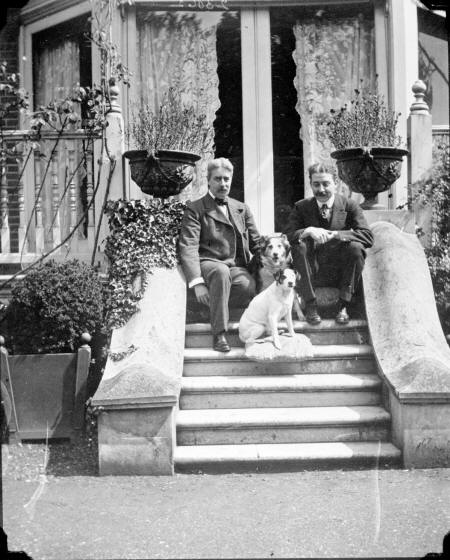

Partner William Haynes-Smith
Queer Places:
Eton College, Windsor SL4 6DW, Regno Unito
University of Cambridge, 4 Mill Ln, Cambridge CB2 1RZ
 Howard
Overing Sturgis[1] (January 30, 1855 – February 7, 1920) was an English-language novelist who wrote about same-sex love. Of American parentage, he lived and worked in Britain.
Tim (1891) is cited as example
in Sexual Heretics: Male Homosexuality in English Literature from 1850-1900, by
Brian Reade.
Howard
Overing Sturgis[1] (January 30, 1855 – February 7, 1920) was an English-language novelist who wrote about same-sex love. Of American parentage, he lived and worked in Britain.
Tim (1891) is cited as example
in Sexual Heretics: Male Homosexuality in English Literature from 1850-1900, by
Brian Reade.
Howard Overing Sturgis was born in Britain on 30 January 1855, in London. He was born into an affluent New England American family: his father, Russell Sturgis (1805–1887), was a China trader and lawyer who later became head of Barings Bank. His mother was Russell's third wife, Julia Overing ''née'' Boit. Sturgis had a brother, Julian, who also became a novelist, and a half-brother, John Hubbard Sturgis, who was a noted Boston architect.[2] His parents sent him to be educated at Eton College. He went on to study at the University of Cambridge.
Henry James met Edith Wharton at the Paris home of Edward Darley Boit, whose daughters would be the subject of the marvelous painting by John Singer Sargent at the MFA in Boston. They had other connections. Wharton was friends with Howard Sturgis, whom she had met in Newport. James had met Sturgis when he was 18 and James was 30. The Sturgises were an old Yankee Boston family and Howard's father had settled in London to run the Barings Bank.
After the death of his mother in 1888 Howard
Sturgis moved with his lover,
William Haynes-Smith, into a country house named Queen's Acre, near Windsor Great Park.
Their home was a familiar retreat for many other bachelors in Henry James'
circle, including Arthur Christopher
Benson, Percy Lubbock, and
Gaillard Lapsley. Haynes-Smith was a distant
relative, born in British Guyana. Sturgis dedicated his first book (an
anonymous novel about love at a same-sex boarding school) to him. Haynes-Smith
was called the "Babe" by the couple's friends. Many did not like him because
they thought him unreliable and a burden to Sturgis. They were wrong.
Haynes-Smith stayed with Sturgis to the end, nursing him as he succumbed to
cancer. In 1924 Haynes-Smith married Sturgis' first cousin, Alice Maud Sturgis
(she was related to Odgen Codman,
an interior designer and friend of Edith Wharton).
Sturgis's first novel, ''Tim: A Story of School Life'' (1891), was published anonymously and was dedicated to the "love that surpasses the love of women." It describes the love of two youths at boarding-school. It was followed in 1895 by ''All that was possible,'' an epistolary novel about a retired actress. Sturgis's first two novels were successful as far as sales were concerned; but his third, ''Belchamber'' (1904), failed to gain the same plaudits. Although Edith Wharton praised it, Henry James found it unsatisfactory,[4] and afterwards Sturgis went on to publish only one short story (1908), about a lesser writer driven suicidal by the criticism of a greater, and a memorial on his friend, Anne Thackeray.
Henry James became closer to Howard Sturgis after 1900 when he developed an intense crush on him. George Santayana wrote that Sturgis "became, save for the accident of sex, which was not yet a serious encumbrance, a perfect young lady of the Victorian type."
In Howard Sturgis’s Belchamber (1904), the puny Lord Charmington, known as ‘Sainty’, is as homosexual as it is possible to be without actually being gay.
In 1912, George Santayana resigned his position at Harvard to spend the rest of his life in Europe. A reason behind his leaving for England must have been the relative freedom of cousin Howard Sturgis, who lived openly as a gay man in the years between 1890 and WWI. Santayana would later remember how Sturgis' Windsor estate was a mecca of gay life at the time. "It seemed a bower of roses. He played by turns the Fairy Prince and the disconsolate Pierrot, now full of almost tearful affection, now sitting dressed in sky-blue silk at the head of his sparkling table, surrounded by young dandies and distinguished elderly dames."
Sturgis died on 7 February 1920. After his death appreciations of him were published by A. C. Benson (1924), Edith Wharton (1934), E. M. Forster (1936) and George Santayana (1944), his cousin. His great-nephew is the journalist and novelist Henry Porter.
My published books: